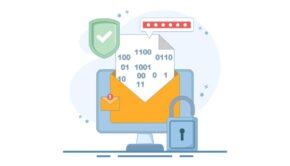Understanding the Landscape: Key Cybersecurity Risks in Fintech
The fintech sector, while revolutionizing the financial industry through technology, faces significant cybersecurity challenges. High-profile breaches, such as the Equifax hack in 2017, which exposed the personal information of 147 million people, underscore the critical need for robust cybersecurity measures. Fintech companies, dealing with vast amounts of sensitive financial data, are prime targets for cybercriminals. The key risks include data breaches, ransomware attacks, and system vulnerabilities. These threats not only compromise customer trust but also pose severe financial and reputational risks to companies. To mitigate these challenges, it is essential for fintech firms to implement multi-layered security protocols, including encryption, access controls, and regular security audits. Additionally, fostering a culture of cybersecurity awareness among employees can significantly reduce the risk of data breaches caused by human error. Case studies, such as the attack on the SWIFT banking network, highlight the sophistication of cyber threats facing the fintech industry and the importance of proactive and comprehensive security strategies.
The Human Factor: Addressing Social Engineering and Insider Threats
Understanding the complexities of human behavior plays a pivotal role in fortifying fintech cybersecurity measures. Social engineering exploits the natural tendency of individuals to trust, making it a potent tool in the hands of cybercriminals. These tactics often involve manipulating employees into divulging confidential information or performing actions that compromise security. Therefore, enhancing awareness and training among staff is crucial. It’s not just about having the most advanced technology; the human element must be educated and prepared to recognize and respond to these threats effectively.
Insider threats, whether intentional or accidental, pose a significant risk to the integrity of financial technology infrastructures. These can range from employees sharing sensitive information unintentionally to malicious insiders seeking to benefit personally. Addressing this challenge requires a comprehensive approach that includes strict access controls, continuous monitoring of sensitive transactions, and fostering a culture of security within the organization. By implementing these strategies, fintech companies can significantly mitigate the risks associated with the human factor and ensure a more secure environment for their operations and data.
Strengthening Defenses: Best Practices in Fintech Cybersecurity
With the rapid evolution of digital finance, the importance of robust cybersecurity measures cannot be overstated. Companies within the fintech sector are prime targets for cybercriminals due to the vast amounts of financial and personal data they handle. Implementing multi-factor authentication (MFA) is a critical step in safeguarding user accounts from unauthorized access. MFA requires users to provide two or more verification factors to gain access to their accounts, significantly reducing the risk of successful cyber attacks. For instance, a comparison between companies that have implemented MFA and those that haven’t shows a marked decrease in account takeover incidents by up to 99.9% according to Microsoft’s research.
Encryption technologies play a pivotal role in protecting sensitive data both at rest and in transit. Utilizing advanced encryption standards (AES) ensures that data, if intercepted, remains unreadable and secure from unauthorized access. A comparison of encryption methods, such as AES 256-bit encryption versus older DES (Data Encryption Standard) methods, reveals the superiority of AES in terms of security and speed. For example, AES 256-bit encryption is currently considered unbreakable by brute force attacks using conventional computing, making it a gold standard for securing financial transactions and data storage in the fintech industry.
Regular security audits and compliance checks are indispensable for identifying vulnerabilities and ensuring adherence to international cybersecurity standards. These audits help in pinpointing weak spots in a fintech’s cybersecurity armor, allowing for timely remediation. For instance, companies adhering to the Payment Card Industry Data Security Standard (PCI DSS) and undergoing regular audits have significantly fewer data breaches compared to those not following these guidelines. A study comparing fintech companies compliant with PCI DSS versus non-compliant ones showed a 50% lower incidence of data breaches among compliant companies. This underscores the importance of regular audits and compliance in fortifying fintech cybersecurity defenses.
Leveraging Technology: Advanced Tools for Fintech Security
As fintech companies continue to evolve, so too do the cybersecurity threats they face. It’s imperative that these organizations employ advanced technological tools to safeguard their operations and customer data. Among the most effective strategies is the implementation of machine learning algorithms for anomaly detection. These algorithms can analyze patterns of behavior and identify potential threats in real-time, significantly reducing the risk of data breaches and financial fraud.
Moreover, the adoption of blockchain technology has emerged as a powerful tool in enhancing fintech security. By creating a decentralized and immutable ledger for transactions, blockchain technology provides an additional layer of security that is particularly resistant to tampering and fraud. Key benefits include:
- Enhanced transparency: Every transaction is recorded and easily verifiable.
- Improved security: Decentralization makes it harder for hackers to exploit vulnerabilities.
- Reduced costs: By eliminating intermediaries, blockchain can lower transaction fees.
Another critical component in the fintech security arsenal is the use of multi-factor authentication (MFA). MFA adds an extra layer of security by requiring users to provide two or more verification factors to gain access to their accounts. This method significantly diminishes the likelihood of unauthorized access, even if a user’s password is compromised. Embracing these advanced tools not only fortifies a fintech company’s defenses but also builds trust with its customers, ensuring their data remains secure in an increasingly digital world.
Compliance and Regulations: Navigating the Legal Framework
Navigating the legal framework within the fintech sector presents a unique set of challenges, primarily due to the dynamic nature of both technology and financial regulations. Firms must ensure they are not only compliant with current laws but also prepared for future legislative changes. This requires a proactive approach, where continuous monitoring and adaptation of compliance strategies are essential. Key to this is understanding the specific requirements laid out by various regulatory bodies, which can vary significantly across different jurisdictions.
To effectively manage compliance and regulatory challenges, fintech companies should consider the following strategies:
- Implementing robust compliance management systems that are flexible enough to adapt to new regulations.
- Engaging in regular training for staff on the latest compliance and regulatory requirements, ensuring that everyone is aware of their responsibilities.
- Collaborating with legal experts who specialize in fintech, to gain insights into how best to navigate the legal landscape.
- Utilizing technology solutions like regulatory technology (RegTech) to streamline compliance processes and reduce the risk of non-compliance.
These steps can significantly mitigate the risks associated with compliance and regulatory challenges, enabling fintech firms to focus more on innovation and less on legal hurdles.
Building a Resilient Culture: Training and Awareness in Fintech Firms
Creating a culture of cybersecurity within fintech firms is not just about implementing the latest technologies; it’s about empowering every employee to be a part of the defense mechanism. Experts agree that human error often leads to security breaches, making it crucial for companies to invest in regular and comprehensive training programs. These programs should not only cover the basics of cybersecurity but also be tailored to address the specific threats that fintech companies face. By fostering an environment where employees are continuously educated on the importance of cybersecurity, firms can significantly reduce their vulnerability to attacks.
Engaging employees in cybersecurity efforts requires more than just occasional training sessions; it involves building a culture where security is everyone’s responsibility. This can be achieved by integrating cybersecurity practices into daily routines and encouraging employees to stay vigilant at all times. Experts recommend using real-world examples of cyber attacks in training sessions to illustrate the potential consequences of negligence. Additionally, rewarding employees who identify vulnerabilities or suggest improvements to the firm’s cybersecurity measures can motivate others to take an active role in safeguarding the company’s digital assets.
Adapting to the ever-evolving landscape of cyber threats is a continuous challenge for fintech firms. To stay ahead, companies must not only update their technical defenses but also ensure that their workforce is equipped with the knowledge and tools to respond effectively. This means regularly assessing and updating training programs to reflect the latest cybersecurity trends and threats. Collaboration with cybersecurity experts and institutions for up-to-date training materials and insights can also enhance the effectiveness of these programs. Ultimately, a well-informed and vigilant workforce is a critical component of a comprehensive cybersecurity strategy in the fintech sector.
Future-Proofing Fintech: Emerging Trends and Cybersecurity Innovations
Cybersecurity in the fintech sector is evolving at an unprecedented pace, driven by both the ingenuity of cybercriminals and the innovative spirit of the industry itself. To stay ahead, businesses must embrace a proactive approach, focusing on emerging trends and cybersecurity innovations. This includes the adoption of advanced encryption methods, the implementation of robust access control systems, and the continuous monitoring of network activity. By doing so, fintech companies can not only protect their current operations but also future-proof their businesses against emerging threats.
Several key trends are shaping the future of cybersecurity in fintech. These include:
- Artificial Intelligence (AI) and Machine Learning (ML) for predictive threat analysis and real-time security decision-making.
- Blockchain technology for secure, tamper-proof transactions and data storage.
- Biometric security measures, such as fingerprint and facial recognition, for enhanced user authentication.
Embracing these technologies can significantly bolster a fintech company’s defenses, making it more difficult for cybercriminals to breach their systems.
Overcoming the cybersecurity challenges in fintech requires a multifaceted strategy. It’s crucial for companies to not only invest in the latest security technologies but also foster a culture of cybersecurity awareness among their employees. Regular training sessions, simulations of phishing attacks, and updates on the latest cyber threats can empower staff to become the first line of defense. Furthermore, partnering with cybersecurity experts and leveraging their insights can provide an additional layer of protection, ensuring that fintech companies remain resilient in the face of evolving cyber threats.
Cover Image: Freepik
















